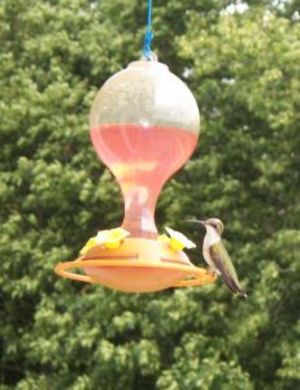Nebraska is teeming with the opportunity for residents and visitors alike to encounter the wildlife that calls this state home. With wildlife areas, parks or just a quiet retreat in the yard, the possibilities are endless when it comes to witnessing what the wildlife in the area has to offer. But, when this wildlife is mentioned, I doubt that the tiny hummingbird is high on the list of animals that comes to mind. The good thing for bird watchers in this state is that Nebraska has four species of hummingbirds that are temporary residents, which are the Ruby-throated Hummingbird, the Rufous Hummingbird, the Broad-tailed Hummingbird and the Calliope Hummingbird.
People in Nebraska can begin looking for these tiny birds in April and have the opportunity to enjoy them until the middle of September. Identifying hummingbirds in Nebraska has to begin with becoming familiar with the species that become temporary residents each year. Learning to look for the features that make the male and female of each of these species different is important to this identification. The color of the feathers covering the throat, back, crown, breast and tail are important indicators of which species is being identified.
Identifying the Ruby-throated Hummingbird begins with the male of the species. The most identifiable feature of the male Ruby-throated Hummingbird is its ruby colored throat, which, by the way, is where the species gets its name. The male of this species also has a forked tail and an emerald back that are features to look for when attempting to identify him. The female Ruby-throated Hummingbird also has an emerald colored back, like the male, but this is where the similarity ends between the sexes. The other features the female Ruby-throated Hummingbird has are a white colored breast, throat, and white-tipped, rounded tail feathers.
Identifying the Rufous Hummingbird is almost as easy as identifying the Ruby-throated Hummingbird. Once again, the male of the species is the easiest to identify, so that is where we will begin, by looking at the rufous colored feathers that cover its crown, sides and its tail. Other outstanding features of this male hummingbird are its back that is green, rufous or a combination of both, a throat that is orange-red colored and a white breast. The female Rufous Hummingbird is not as easily identified as the male because its does not have any outstanding features to look for, but it does have a green back and crown, a white breast, a streaked throat and tail feathers that are rufous with white tips.
Identifying the Broad-tailed Hummingbird is achieved much like the species already discussed, by discussing the outstanding features of the male, which are a rose throat, a white breast, a metallic back and crown and a rounded tail. The female Broad-tailed Hummingbird is not as brightly colored as the male but does have a green back and crown, a black and white spotted throat, rufous colored sides and tail feathers that are green in the middle, rufous on the outside and black in the middle with white tips.
Identifying the Calliope Hummingbird is a little different, especially if there is more than one species of hummingbird in the area to be identified. This is because the Calliope Hummingbird is the smallest hummingbird in Nebraska, with males that weigh in the area of 2.5 grams and females weighing about 2.8 grams. Although size could be used for identification if the circumstances are favorable, it never hurts to know what other features to look for when attempting to identify this tiny bird. To identify the male Calliope Hummingbird, look for a “whiskered” effect on the bird’s throat, created by purple rays throughout a white covered throat. This male hummingbird also has a metallic green back and crown. The female Calliope Hummingbird is not as easy to identify as the male, mostly because it does not have the purple rays on its throat, instead it has a white throat with dark streaks. The female Calliope Hummingbird also has a green back and crown, its sides are buff colored and its tail feathers are only white-tipped on the corners.
To attract these species of hummingbirds to your piece of Nebraska, a hummingbird garden and/or a hummingbird feeder will need to be in place. When considering a hummingbird garden, plants to include are varieties that have red or orange, tubular blooms. Just such plants that have this type of bloom and do well in Nebraska are columbine, trumpet honeysuckle, jewelweed, blazing stars, bee balm, morning glories, rose-of-Sharon and coralberry. With these plants in place, you should have the perfect situation for hummingbird watching.
